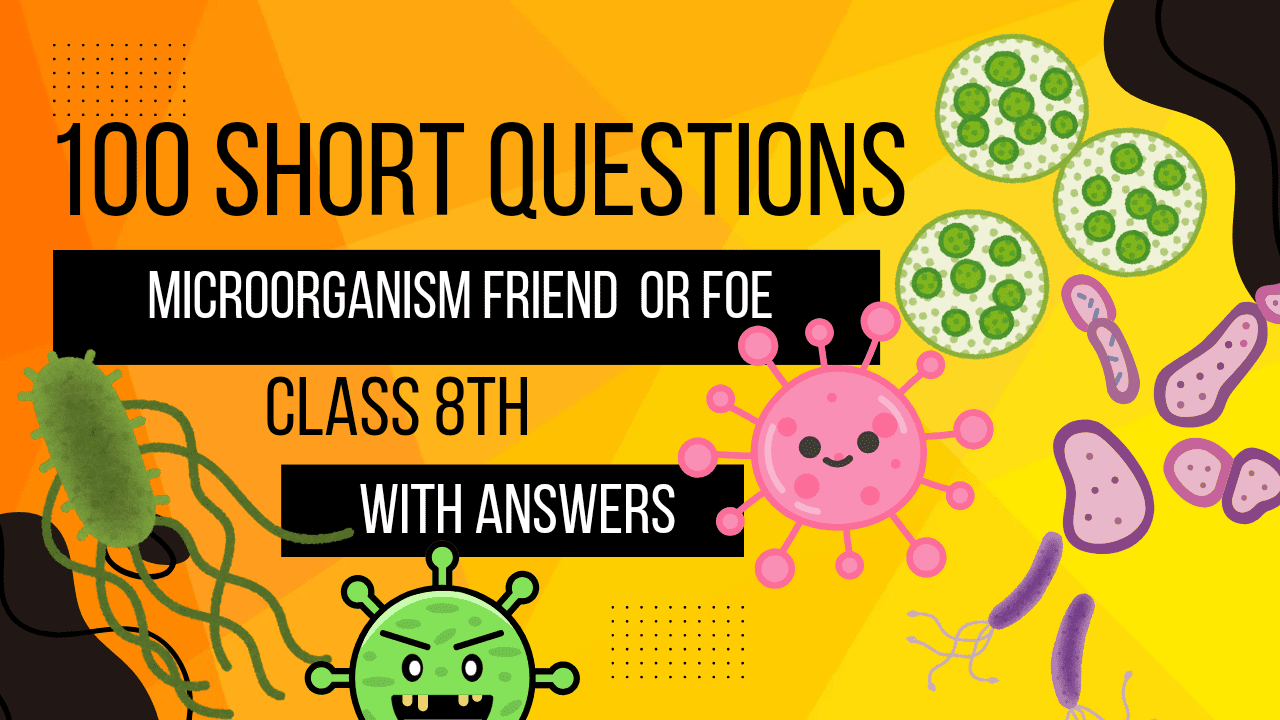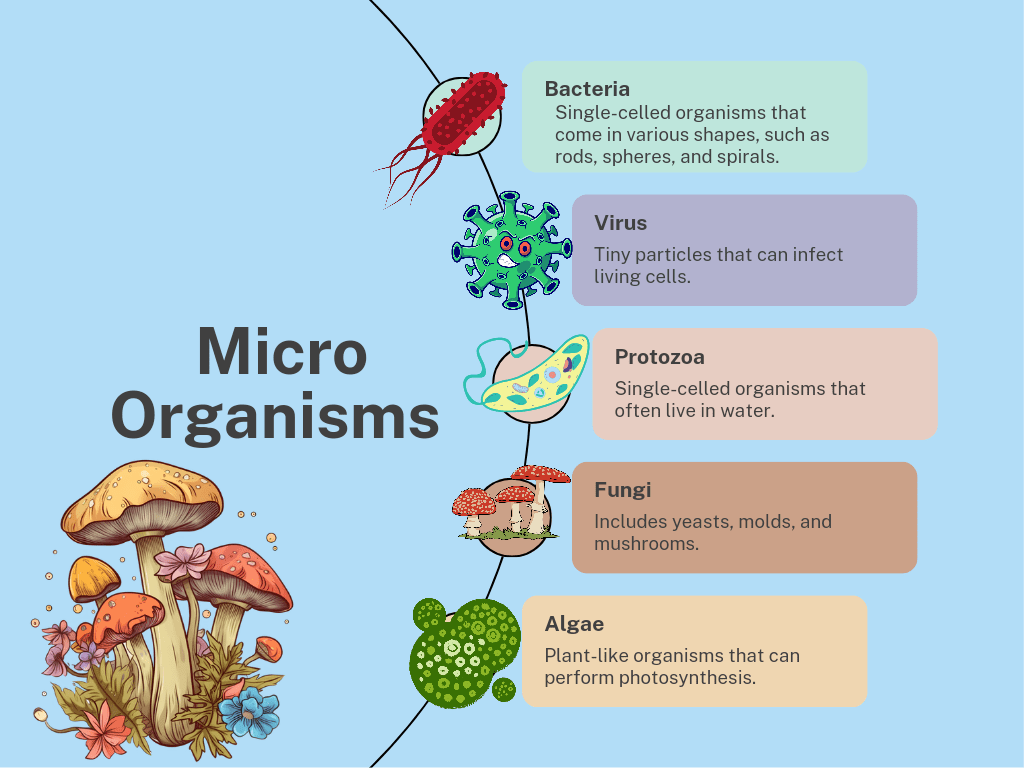Crop Production and Management Class 8 notes
Detailed Topic Explanations, NCERT Solutions & Extra Practice Questions
Table of Contents
Introduction to Crop Production and Management
Agriculture is the science and art of cultivating plants and livestock. It is a vital aspect of human civilization that has evolved over thousands of years. Initially, humans were nomadic, wandering from place to place in search of food and shelter. They ate raw fruits and vegetables and hunted animals for food. Eventually, they learned to cultivate land and produce food crops like rice, wheat, and others, giving birth to agriculture.
Crop: When plants of the same kind are cultivated at one place on a large scale, it is called a crop. For example, a crop of wheat means that all the plants grown in a field are wheat plants.
All living organisms need food to survive. While plants can synthesize their own food through photosynthesis, animals, including humans, cannot produce their own food and rely on plants or other animals for nourishment. For a large population, regular food production, proper management, and effective distribution are necessary.
India is a vast country with varying climatic conditions across different regions. This diversity allows for the cultivation of a wide variety of crops. Despite this diversity, crops in India can be classified into two main categories based on the seasons in which they grow:
Two Main Crop Categories in India
- Kharif Crops: These are crops sown in the rainy season (June to September). Examples include paddy, maize, soybean, groundnut, and cotton.
- Rabi Crops: These are crops grown in the winter season (October to March). Examples include wheat, gram, pea, mustard, and linseed.
Additionally, pulses and vegetables are grown during summer in many places.
Agricultural Practices
Agricultural practices refer to the various activities or tasks undertaken by farmers over a period of time to cultivate crops. These activities are similar to those performed by gardeners or even by individuals growing ornamental plants at home.
The cultivation of crops involves several sequential steps. Each step is crucial for ensuring healthy crop growth and maximum yield. Some crops require specific conditions and care, making it essential for farmers to understand the needs of different plants.
The transition from nomadic life to settled agriculture was a significant milestone in human history, often referred to as the Neolithic Revolution. This shift allowed for the development of permanent settlements, accumulation of resources, and eventually, the rise of complex civilizations.
Basic Practices of Crop Production
The cultivation of crops involves several activities that farmers undertake over a period. These activities are essential for ensuring good crop yield and are collectively referred to as agricultural practices. The main agricultural practices include:
- Preparation of soil: This involves tilling and loosening the soil to make it suitable for cultivation.
- Sowing: This involves planting seeds in the prepared soil.
- Adding manure and fertilizers: This involves enriching the soil with nutrients for better crop growth.
- Irrigation: This involves supplying water to crops at appropriate intervals.
- Protecting from weeds: This involves removing unwanted plants that compete with crops for nutrients.
- Harvesting: This involves collecting mature crops from the field.
- Storage: This involves preserving harvested crops for future use.
These practices are followed in a sequence, with each practice being crucial for the success of the subsequent ones. Let’s explore each of these practices in detail.
Preparation of Soil
The preparation of soil is the first step before growing a crop. One of the most important tasks in agriculture is to turn the soil and loosen it. This allows the roots to penetrate deep into the soil. The loose soil allows the roots to breathe easily even when they go deep into the soil.
Benefits of Loosening Soil:
- It helps in the growth of earthworms and microbes present in the soil.
- These organisms are friends of the farmer since they further turn and loosen the soil and add humus to it.
- Turning and loosening of soil brings the nutrient-rich soil to the top so that plants can use these nutrients.
The process of loosening and turning of the soil is called tilling or ploughing. This is done by using a plough. Ploughs are made of wood or iron. If the soil is very dry, it may need watering before ploughing. The ploughed field may have big clumps of soil called crumbs. It is necessary to break these crumbs. Levelling the field is beneficial for sowing as well as for irrigation. Levelling of soil is done with the help of a leveller. Sometimes, manure is added to the soil before tilling. This helps in proper mixing of manure with soil. The soil is moistened before sowing.
Agricultural Implements for Soil Preparation
Plough: This tool has been used since ancient times for tilling the soil, adding fertilizers to the crop, removing weeds, and turning the soil. It is made of wood and is drawn by a pair of bulls or other animals like horses or camels. The main component of a plough is a triangular iron strip called a ploughshare attached to a long wooden log known as a ploughshaft. One end of the shaft has a handle, while the other is connected to a beam placed on the bulls’ necks.
Hoe: A hoe is a simple tool used for removing weeds and loosening the soil. It consists of a long rod of wood or iron with a strong, broad, bent iron plate fixed to one end that functions as a blade. It is pulled by animals.
Cultivator: Modern farming employs tractor-driven cultivators for ploughing. This method saves both labor and time compared to traditional ploughing techniques.
Sowing
Sowing is an important part of crop production. Before sowing, good quality, clean, and healthy seeds of a good variety are selected. Farmers prefer to use seeds that give high yield.
Selection of Seeds
Good seed selection is crucial for successful crop production. One method to separate good, healthy seeds from damaged ones is by placing them in water:
Activity: Seed Selection
- Take a beaker and fill half of it with water.
- Put a handful of wheat seeds and stir well.
- Wait for some time.
- Observe that some seeds float on water.
Explanation: Damaged seeds become hollow and lighter, causing them to float on water. Healthy seeds, being heavier, sink to the bottom.
Sowing Tools
Traditional Tool: The traditional tool used for sowing seeds is shaped like a funnel. Seeds are filled into the funnel and passed down through two or three pipes with sharpened ends. These ends pierce into the soil and place seeds there.
Seed Drill: Modern farming uses seed drills for sowing with the help of tractors. This tool sows seeds uniformly at equal distances and depths, ensuring the seeds get covered by soil after sowing. This protects seeds from being eaten by birds. Using a seed drill saves time and labor.
Seeds of some plants, such as paddy, are first grown in a nursery. When they develop into seedlings, they are manually transplanted to the field. This method is also used for many forest plants and flowering plants.
Maintaining appropriate distances between seeds is necessary to prevent overcrowding of plants. Proper spacing allows plants to receive sufficient sunlight, nutrients, and water from the soil. Sometimes, thinning (removing some plants) may be required to prevent overcrowding.
Adding Manure and Fertilizers
The substances which are added to the soil in the form of nutrients for the healthy growth of plants are called manure and fertilizers. Soil supplies mineral nutrients to the crop plants, which are essential for their growth.
In areas where farmers grow crop after crop in the same field, the soil becomes depleted of nutrients over time. To replenish these nutrients, farmers add manure to the fields, a process called manuring. Without proper manuring, plants may grow weak and yield less produce.
Manure: Manure is an organic substance obtained from the decomposition of plant or animal wastes. Farmers dump plant and animal waste in pits at open places and allow it to decompose through the action of microorganisms. The decomposed matter is then used as organic manure.
Fertilizers: Fertilizers are chemicals that are rich in particular nutrients. They differ from manure in that they are produced in factories. Examples include urea, ammonium sulphate, superammonium phosphate, potash, and NPK (Nitrogen, Phosphorus, Potassium).
Comparison Between Fertilizers and Manure
| Fertilizers | Manure |
|---|---|
| Fertilizer is a man-made inorganic salt. | Manure is a natural substance obtained by the decomposition of cattle dung and plant residues. |
| Fertilizer is prepared in factories. | Manure can be prepared in the fields. |
| Fertilizer does not provide any humus to the soil. | Manure provides a lot of humus to the soil. |
| Fertilizers are very rich in plant nutrients like nitrogen, phosphorus, and potassium. | Manure is relatively less rich in plant nutrients. |
Advantages of Manure
Organic manure is considered better than chemical fertilizers because:
- It enhances the water holding capacity of the soil.
- It makes the soil porous, facilitating the exchange of gases.
- It increases the number of friendly microbes in the soil.
- It improves the texture of the soil.
While the use of fertilizers has helped farmers achieve better yields for crops like wheat, paddy, and maize, excessive use can make the soil less fertile over time and contribute to water pollution. To maintain soil fertility, it’s advisable to use organic manure or practice crop rotation, where fields are occasionally left uncultivated (fallow) between crop cycles or different crops are grown alternately.
One natural method of replenishing soil nutrients is through the use of leguminous plants, which have Rhizobium bacteria in the nodules of their roots. These bacteria can fix atmospheric nitrogen, enriching the soil. For example, farmers in northern India traditionally grew legumes as fodder in one season and wheat in the next, which helped replenish the soil with nitrogen.
Irrigation
All living beings need water to live. Water is essential for the proper growth and development of plants. It is absorbed by plant roots along with minerals and fertilizers. Plants contain nearly 90% water, and it’s vital for various functions:
- Germination of seeds doesn’t occur under dry conditions.
- Nutrients dissolved in water are transported to each part of the plant.
- Water protects crops from both frost and hot air currents.
Irrigation: The supply of water to crops at regular intervals is called irrigation. The time and frequency of irrigation varies depending on the crop type, soil conditions, and season. In summer, watering frequency is higher due to increased evaporation from soil and leaves.
Sources of Irrigation
The main sources of water for irrigation include wells, tubewells, ponds, lakes, rivers, dams, and canals.
Traditional Methods of Irrigation
Water from wells, lakes, and canals is lifted using various traditional methods in different regions. These methods use cattle or human labor, making them cheaper but less efficient:
- Moat (pulley system)
- Chain pump
- Dhekli
- Rahat (lever system)
Modern irrigation often employs pumps powered by diesel, biogas, electricity, or solar energy to lift water more efficiently.
Modern Methods of Irrigation
Modern irrigation techniques help use water more economically, which is especially important in areas with limited water availability:
- Sprinkler System: This system is beneficial for uneven land where water availability is limited. It consists of perpendicular pipes with rotating nozzles on top, connected to a main pipeline. Water under pressure escapes from the nozzles and is sprinkled on crops like artificial rain. This method is particularly useful for lawns, coffee plantations, and various other crops.
- Drip System: In this method, water falls drop by drop directly near the plant roots. It’s highly efficient as water wastage is minimal. The drip system is excellent for watering fruit plants, gardens, and trees, and is particularly valuable in regions with poor water availability.
Protection from Weeds
In agricultural fields, many undesirable plants may grow naturally alongside the cultivated crop. These unwanted plants are called weeds.
Weeds: Undesirable plants that grow naturally along with the crop plants are called weeds.
Weeding: The removal of weeds is called weeding.
Weeding is necessary because weeds compete with the crop plants for water, nutrients, space, and light, affecting crop growth. Some weeds can interfere with harvesting and may even be poisonous for animals and humans.
Methods to Control Weeds
Farmers use several approaches to remove weeds and control their growth:
- Tilling: Ploughing before sowing helps uproot and kill weeds, which then dry up and get mixed with the soil.
- Timing: The best time to remove weeds is before they produce flowers and seeds to prevent their propagation.
- Manual Removal: This involves physically uprooting or cutting weeds close to the ground using tools like a khurpi or a seed drill.
- Chemical Control: Certain chemicals called weedicides, such as 2,4-D, are sprayed in fields to kill weeds without damaging the crops. Weedicides are diluted with water as required and applied using a sprayer.
Safety Precaution: Weedicides should be sprayed during the vegetative growth of weeds, before they flower and form seeds. Since these chemicals can affect human health, farmers should cover their nose and mouth with a cloth during application.
Harvesting
Harvesting is an important task in the agricultural cycle. It refers to the cutting of the crop after it has matured. In harvesting, crops are either pulled out or cut close to the ground. Cereal crops typically take 3 to 4 months to mature and be ready for harvesting.
In India, harvesting is done either manually using a sickle or mechanically with a machine called a harvester. After harvesting, the grain seeds need to be separated from the chaff—a process called threshing. This is often accomplished using a machine called a ‘combine,’ which functions as both a harvester and a thresher.
Sometimes after harvesting, stubble (short stalks left in the field) is burnt by farmers. This practice can cause air pollution and may risk setting fire to crops still in nearby fields. Environmentally conscious farming avoids stubble burning.
For smaller land holdings, farmers separate grain from chaff through winnowing, a process that uses wind to blow away the lighter chaff while the heavier grains fall to the ground.
Harvest Festivals
The harvest season is a time of joy and celebration across India, marking the successful culmination of months of hard work. Various harvest festivals are celebrated in different parts of the country, including:
- Pongal
- Baisakhi
- Holi
- Diwali
- Nabanya
- Bihu
These festivals reflect the cultural importance of agriculture in Indian society and are occasions for community gatherings and thanksgiving for a bountiful harvest.
Storage
Proper storage of harvested produce is crucial to maintain its quality over time. If harvested grains are to be kept for an extended period, they must be protected from moisture, insects, rats, and microorganisms.
Freshly harvested grains contain significant moisture. If stored without proper drying, they can be spoiled by organisms, making them unfit for consumption or germination. Therefore, before storage, grains are thoroughly dried in the sun to reduce their moisture content. This drying process prevents attacks by insect pests, bacteria, and fungi.
Storage Methods
- Small-scale Storage: Farmers typically store grains in jute bags or metallic bins for household or small-scale use. Adding dried neem leaves to storage containers is a traditional method to protect grains from pests.
- Large-scale Storage: For storing large quantities of grains, silos and granaries are used to protect them from pests like rats and insects. These facilities often employ specific chemical treatments to safeguard grains from pests and microorganisms over long periods.
Proper storage is not just about quantity preservation; it’s also vital for maintaining the nutritional value and germination capacity of seeds intended for future planting seasons.
Food from Animals
Just as plants provide us with various foods, animals also contribute significantly to our diet. Many people, especially those living in coastal areas, consume fish as a major part of their diet. Similarly, milk, meat, eggs, and other animal products form essential components of many diets around the world.
Common Food Sources from Animals:
| Food | Sources |
|---|---|
| Milk | Cow, Buffalo, She-goat, She-camel |
| Meat | Goat, Hen, Pig, Duck, Sheep |
| Eggs | Hen, Duck, Goose |
| Honey | Honey bee |
Animals reared at home or on farms need proper food, shelter, and care. When this is done on a large scale, it is called animal husbandry. This practice involves the breeding, feeding, and caring for domestic animals to obtain products like milk, meat, and eggs, or for work and transportation purposes.
Fish is highly nutritious and easily digestible. It provides cod liver oil, which is rich in vitamin D and beneficial for health.



